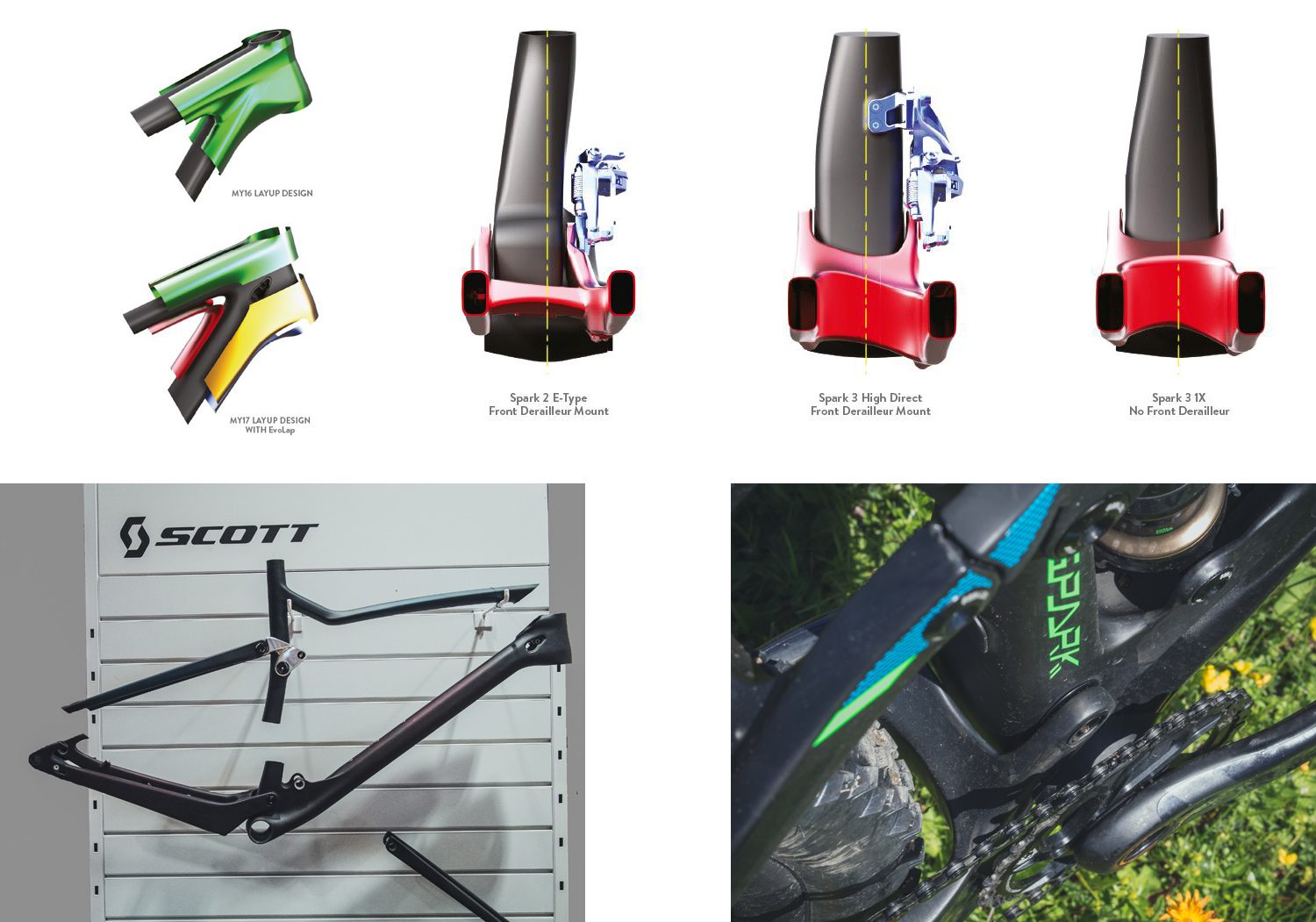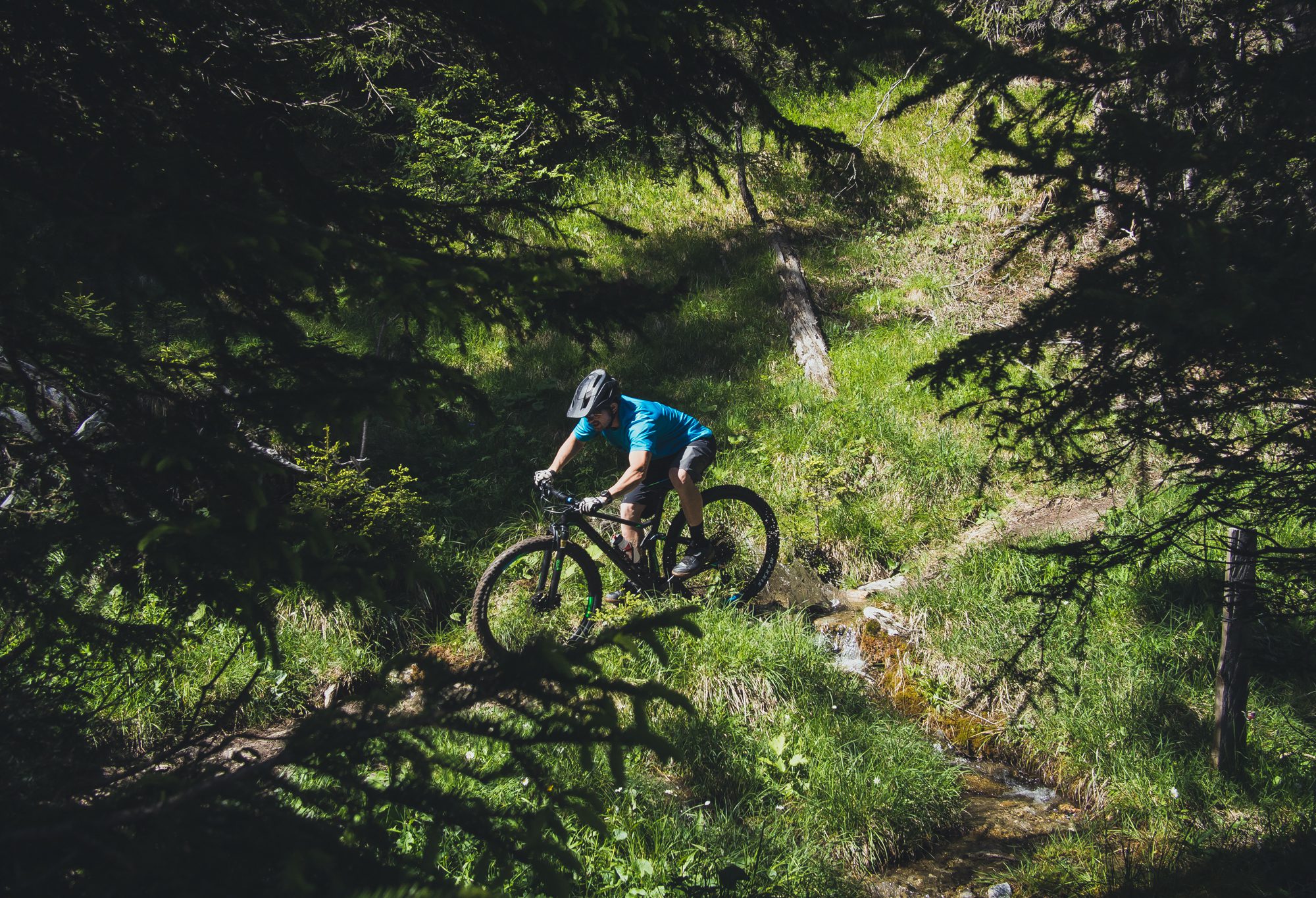First look: 2017 Scott Spark and Scale


With the Rio Olympic Games weeks away and Nino Schurter in the world champion’s rainbow jersey, Scott released its the 2017 line of mountain bikes. The company chose the picturesque mountain village of Lenzerheide in its home country Switzerland for the event. Some of the technologies and products Scott revealed have been in development for four years, from the EvoLap development technology used to shed unwanted grams on frames to eliminating the need for front shifting. The company is now boasting the lightest dual-suspension XC bike on the start line with its Spark. The company’s hardtail Scale model boasts a whopping 849 g frame weight.
Scott Spark
Suspension
The Spark saw a complete re-design. Most notable, the shock mount has changed from a top-tube mount to a down-tube mount. This change allows Scott to shave extra weight from the top tube where extra material is now no longer needed. It also allows for a better shock stroke and the incorporation of Scott’s new trunnion shock mount. The trunnion mount allows shock companies more design space for the same eye-to-eye measurement, as well as increasing overall frame stiffness with a wider mount. Because of this mount, the Fox Nude shock (custom-designed for Scott) is set lower and closer to the seat tube. This change also meant the bottom bracket could be lowered, improving the bike’s handling and giving the rider added standover height.

Carbon
Much attention was also given to the carbon-fibre layup of the frame. Scott designed both the Spark and Scale in two pieces each. The top section of each frame focused on comfort, and the bottom portion focused on stiffness. In each case, the result is a bike that you can ride comfortably all day, while you also have top pedalling performance.
To get the most out of the company’s carbon-fibre weaves (HMX-SL or HMX depending on the model of Spark), Scott relied on its EvoLap development technology, which is a way to make computer models of the various layups. With this system of modelling, engineers and designers could see where they could shave weight and optimize the placement of material. For example, at the head tube/top tube/downtube junction, one piece of carbon fibre used to wrap all three pieces. Now, four are used. Because of this processes, Scott shed 216 g when compared with the previous HMX carbon model. The carbon wizardry doesn’t stop there. With more and more riders choosing to use 1-by drivetrain setups, Scott makes the Spark in both a 1-by specific model, as well as a model with a front-derailleur mount. On the 1-by frame, Scott was able to increase the overall width at the bottom-bracket junction, which increases the frame’s stiffness while dropping weight at same time. The new 2-by Spark gets a direct-mount front derailleur instead of the E-type found on the previous model.

Linkage
A two-piece carbon rocker link is another new addition to the Spark. While many companies use a single-piece link, Scott says by making the link in two pieces, it can shave significant amounts of weight from the inside of the component without sacrificing stiffness. This change reduced the rocker link by half the weight compared with the previous model. Move slightly farther back on the frame, you will see one of the more impressive improvements of the Spark. The rear triangle of the previous model consisted of 18 pieces. The new Spark has a grand total of three: two pieces to the triangle and the brake mount. By making the rear triangle in two pieces, eliminating hardware and adding a new brake mount, Scott saved 130 g on the rear end. The new brake mount is now anchored to the rear chainstay and axel. This arrangement not only saves weight, but allows for even flexing of the rear triangle on the brake-mount side.

With the new line coming in both 1- and 2-by, as well as electronic-shift compatible options and, in some cases, with dropper posts, Scott has addressed internal-cable routing and offers frame adaptors for all configurations. The company has also introduced integration with their house component brand Syncros. The new SL line of stems is designed to integrate with the Scale and Spark’s head tube for a clean look and, according to the company, will give you a weight and stiffness advantage over other aftermarket cockpits. The Spark also gets a geometry upgrade with a slacker 68.5 degree head tube shorter chainstays, longer reach and lower stack height. Scott has made these tweaks to both the Spark and Scale to help them adapt to the more technically demanding trails we are seeing on race courses everywhere.

The Ride
With such a large and diverse line of bikes, Scott has something for every type of rider. From the race-bred RC Scale that weighs less than some road bikes, to the plus-size Scale and Spark that can challenge any terrain, Scott seem to have you covered. Scott is also offering the Scale and Spark in both 29” and 27.5” wheel sizes (including plus-sizes) in multiple build options. I chose to ride a model somewhere in the middle of the line: I spent most of my time in Lenzerheide on the Spark Ultimate (120 mm).
After an easy-breezy suspension setup, I was pedalling into the Swiss Alps. We started up a long cattle road, where I immediately used the TwinLock remote. I have front and rear lockout on my personal bike, but rarely use it. However, with a single lever push, the Fox 34 Float fork and Fox Nude rear shock were stiff and I was climbing with ease. Fully locked out, you can feel all your power transferring into the rear wheel thanks to the HMX carbon and BB92 bottom bracket. Standing up out of the saddle, I felt little flex in the front end while rocking the bike back and forth, no doubt aided by the Syncros Sl bar and FL1.5 stem. While the RockShox Reverb stealth dropper post suggest the bike is better going downhill, the Spark certainly climbs very well. When the cattle road began to narrow into a more technical ascent, unlocking the suspension with a flip of the lever did little to hinder the Spark’s climbing abilities. The rear end maintained traction even over loose shale rock and slippery roots. On some of the steeper sections, I noticed the Spark’s weight as I found I didn’t need the complete gear range offered by the SRAM Eagle drivetrain. With 12 gears and only one shifter to worry about, it’s hard to fathom why anyone would want two rings up front for anything that isn’t a backcountry/bikepacking adventure.

After spending some time on the Swiss trails, it’s easy to see why the country has such strong mountain bikers. The terrain is very technical. With trails that have seen use for hundreds of years, it’s not uncommon to come across deep rooted sections and exposed boulders and rocks. I was glad to have the 120 mm of travel when things got steep and bumpy. With the shorter chainstays and slackened head-tube angle, the Spark puts you in a great position for descending. Add in a dropper post and you can take on sections of steep technical trail faster and with more confidence than you would with other 120 mm travel bikes. I was riding the 29” version of the Scale most of the time and think that the 27.5” version is even better on descents, as I did find myself drifting slightly wide on some corners where the 27.5” wheel seemed to give me more control. On both wheel sizes, Maxxis Forekaster tires kept me planted. The treads were mounted on the new Syncros XR 1.0 carbon hoops. Even when your line starts to stray and you need to soak up some big bumps, the Scale can handle it without bucking you off into the woods. That maked me ask: is this an XC bike? Or is this a trail bike? I don’t think it needs to be put into a category, and that is why I like it. The Scale Ultimate (120 mm) is whatever you want it to be. Lock out the suspension and the lightweight frame and materials help you to climb like a mountain goat. Or, drop the seatpost, lean back and let the Spark deliver you to the bottom of a technical downhill with ease. If you’re looking for one bike to do it all, this one should definitely be on your list.

Scott Scale
Boasting the lightest hardtail mountain bike frame on the market at 849 g, the Scale is a pure race machine. Designers focused on two sections of the Scale: one managed comfort; the other, power transfer. The seatstays, top tube and seat tube are designed to focus on comfort, flexing to give the rider more compliance. The head tube, down tube and chainstays were optimized for maximum stiffness and energy transfer, ensuring the most amount of forward momentum. The Scale is offered in both 29” and 27.5” wheel sizes and multiple build and frame-material options.

Plus Spark/Scale
With the plus-size category growing in popularity, Scott has expanded and updated its plus-size options to include the Spark Plus (130 mm, 27.5”) and the Scale Plus hardtail (120 mm, 27.5”), respectively. The Spark Plus shares all of the same material and design features that the main line sports, including HMX carbon and trunnion shock mount. The 130 mm of travel makes it a very capable bike. The Scale hardtail is also updated and now most models come equipped with a dropper post and updated geometry.

